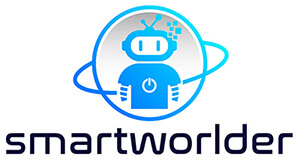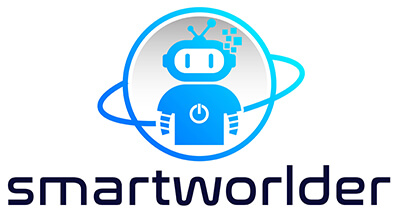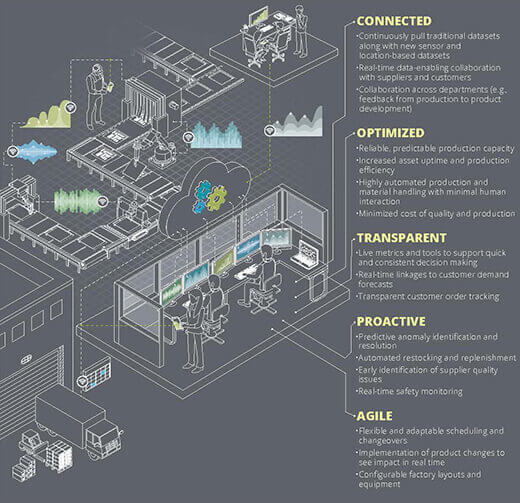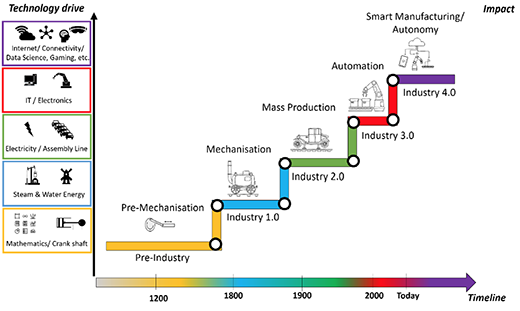Smart Factory
Content
– Smart Manufacturing and Industry 4.0
– Drivers and Key Components of Smart Factories
– Internet of Things
– Cyber-Physical Systems
– Smart Factory Components
The basic smart technologies enabling a Smart Factory are not that different from a smart home – sensors, actuators, computer processing, algorithms and connectivity. But that’s where the similarities end. Modern factories are highly complex systems with sophisticated processes and requirements.
The smart factory represents a leap forward from more traditional automation to a digital, fully connected and flexible system—one that can use a constant stream of data from connected operations and production systems to learn and adapt to new demands.
Smart factories combine the benefits of mass production with the objectives of customized production.
A commonly accepted definition of a smart factory is a flexible system that can self-optimize performance across a broad network, self-adapt to and learn from new conditions in real or near-real time, and autonomously run entire production processes. The benefits are greater asset efficiency, lower cost, better quality, and enhanced safety and sustainability.
Enabled by sensors, sophisticated data processing and interconnected components allow an environment in which machines, single modules, entire systems, products, materials and humans organize themselves to optimize throughput with efficient resource usage.
Smart factory systems even allow for direct communication between the product (work piece) and the production system: the product contains all the necessary manufacturing information in electronic form with it, i.e., on an RFID chip. Based on this data, the way of the product through the complete production chain can be tracked and traced.
Smart Manufacturing and Industry 4.0
The terms smart factory and smart manufacturing are often used synonymously. Manufacturing is the production of goods through the use of labor, machines, tools, and chemical or biological processing or formulation. In a wider sense, 'manufacturing' is also used to describe an entire sector of the economy.
In that wider sense, smart manufacturing also includes other economic stakeholders such as smart logistics (for instance smart roads), specialized service providers and creative start-ups. For the purpose of this article, let's focus on factories.
Germany and the USA pay special attention to the implementation of digital transformation principles in manufacturing. Namely, the governments of these countries have developed strategic initiatives for the creation of smart manufacturing ('Industry 4.0' in Germany, 'Advanced Manufacturing' in the USA).
The term Industry 4.0 is often used to refer to the fourth industrial revolution – after mechanization (Industry 1.0), mass production (Industry 2.0), and automation (Industry 3.0) – that paves the way for personalized products, resource-efficient logistics, new services and a more flexible working environment. The term was coined by the German Government's national strategic initiative “High Tech 2020” to drive digital manufacturing forward by increasing digitalization and enhancing competitiveness in the manufacturing industry. It has since been updated with High-Tech Strategy 2025.
Although Germany was the first to tap into this new way of pursuing digitalization in the manufacturing industry it has become a global trend and the race to adapt Industry 4.0 is already happening in Europe, USA and Asia.
At the core of these strategic programs for smart manufacturing is the smart factory. Smart factory processes require advanced digital technologies that connect, integrate and use effectively assets, processes, people, and devices.
Smart manufacturing will fundamentally change the way the products are invented, manufactured, shipped and sold. It will improve employees’ safety and protect the environment by making zero-emissions, zero-incident manufacturing possible.
Drivers and Key Components of Smart Factories
Internet of Things
The Internet-of-Things (IoT) is the infrastructure of interconnection among objects. In manufacturing systems, each device is embedded with electronic software, sensors, and actuators and is connected to Internet networks.
The IoT enables manufacturing devices to exchange data within manufacturing devices, between manufacturing devices and other factory systems (purchasing, maintenance, etc.) and their service providers or consumers. Sensors are embedded in physical objects such as vehicles, heavy equipment (cranes, automated guided vehicles (AGVs), loaders), machines, and robots.
Cyber-Physical System
The communication and foundation of the IoT are the inspiration for Cyber-Physical Systems (CPS). The foundation of big data, the accessibility potential of the IoT and the analytics promised by cloud computing make it possible to integrate the physical and virtual worlds. This integration is known as CPS, which integrates computations with physical processes.
Embedded computers and networks monitor and control physical processes, usually with feedback loops in which physical processes affect computations and vice versa. This means that information about manufacturing components on the shop floor (i.e., machines, robots) and their corresponding modules in virtual space are synchronized.
The implementation of Industrial IoT (IIoT) and CPS technologies in manufacturing systems has added new capabilities, enabling the management of complex and flexible systems to satisfy rapid changes in production volumes and customization.
These new technologies result in increasing context-awareness to assist factory staff and machines in the perfect execution of their tasks. Awareness refers to the availability of knowledge of system components, the history of system performance and the ongoing state of the system.
These components are transforming the concept of the traditional factory toward a new type of manufacturing system – commonly described as a smart factory.
Smart Factory Components
The following design principles of a smart factory help designers build new smart factories or upgrade existing traditional factories to be smart.
Modularity Modularity is the capability of system components to be separated and combined easily and quickly. System components are loosely coupled and can be reconfigured on a plug-and-play principle to allow the production system to respond to changing customer requirements and to overcome internal system malfunctions. For example, modules can be added, rearranged or relocated in the production line on-time. The smart factory should possess high modularity, allowing the rapid integration of modules that can be supplied by multiple vendors.
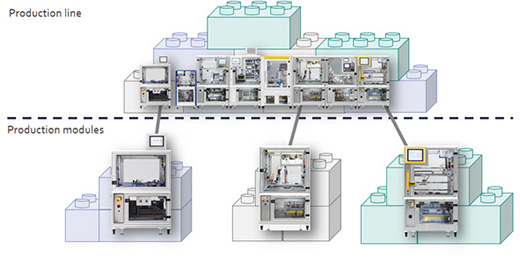
Interoperability The ability to share technical information within system components, including products and to the ability to share business information between manufacturing enterprises and customers. Standardized mechanical, electrical and communication information is essential to enhancing interoperability.
Decentralization The key to decentralization is that system elements – modules, material handling, products, etc. – will make decisions on their own, unsubordinated to a control unit, in real time and without violating the overall organizational goal.
Embedded computers enable autonomous CPS to interact with their environment via sensors and actuators. Such interaction will adapt processes to each individual order, enabling low-cost, custom-tailored products.
Virtualization This refers to both creating an artificial factory environment with CPS similar to the actual environment and to being able to monitor and simulate physical processes.
Information transparency in CPS and the aggregation of sensor data enable the creation of such an environment. A virtual system is used to monitor and control all physical aspect, which sends data to update its virtual model in real time. A virtual system enables the implementation of designs, creating digital prototypes that are very similar to the real ones. The design can be checked, modified, and tested prior to its order into the physical system.
In addition, a virtual system is helpful for other issues such as training the workforce, guiding the workforce while performing manual processes, diagnosing, and predicting faults and guiding maintenance tasks to fix malfunctions. Virtual reality and augmented reality combination with mobile devices provide customers more insight into the detailed design of their products and allow them to track the manufacturing process.
Service orientation This refers to the idea that manufacturing industries will shift from selling products to selling products and services. Manufacturing industries are becoming service providers as their products have reached competitive equality. Using such a strategy, a product can be sold to customers with almost no margin or profit. Instead of focusing on profit from selling the product, organizations focus on selling the service. Products and services will be integrated and sold together.
Today, manufacturing industries outsource some of their services, focusing on their core businesses. In the smart factory, manufacturing industries will move towards outsourcing some of their processes and concentrating on their core processes.
Such a strategy encourages innovation in the improvement of core process(s) in which the resources are concentrated and will not disperse. In turn, a manufacturing industry will sell its core process(s) as a service to another industry. CM describes an infrastructure that uses the Internet as a medium for offering and selling services, where cloud computing plays an important role in enabling the on-demand provision of services.
Real-time capability (responsiveness) This refers to the ability of the system to respond to changes on time, such as changes in customer requirements or the status of the internal production system (e.g., malfunctions and resource failures).
To respond to customer requirements, information should be accessed and analyzed in real time. The system will investigate the possibility of meeting requirements using existing resources through reconfiguration or cooperation with other factories via CPS and CM requesting services (processes) that are not available in the factory. The system should have a sufficient degree of modularity to accomplish such a reconfiguration. Responses to internal changes, monitoring and controlling should be in real time. Disturbances should be detected on time, and the system should have the ability to recover rapidly.
In summary, when fully realized, smart factories use fully integrated, collaborative manufacturing systems to make operations flexible, adaptable, and optimizable. By continuously improving the productivity of manufacturing processes, smart factories can lower costs, reduce downtime and minimize waste. Identifying and reducing misplaced or underused production capacities mean opportunities for growth without investing in additional monetary and/or physical resources.
Check out our SmartWorlder section to read more about smart technologies.

